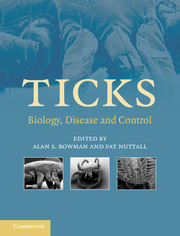Book contents
- Frontmatter
- Contents
- List of contributors
- Preface
- 1 Systematics and evolution of ticks with a list of valid genus and species names
- 2 The impact of tick ecology on pathogen transmission dynamics
- 3 Tick salivary glands: the physiology of tick water balance and their role in pathogen trafficking and transmission
- 4 Tick saliva: from pharmacology and biochemistry to transcriptome analysis and functional genomics
- 5 Tick toxins: perspectives on paralysis and other forms of toxicoses caused by ticks
- 6 Tick lectins and fibrinogen-related proteins
- 7 Endocrinology of tick development and reproduction
- 8 Factors that determine sperm precedence in ticks, spiders and insects: a comparative study
- 9 Tick immunobiology
- 10 Saliva-assisted transmission of tick-borne pathogens
- 11 Lyme borreliosis in Europe and North America
- 12 Viruses transmitted by ticks
- 13 Babesiosis of cattle
- 14 Theileria: life cycle stages associated with the ixodid tick vector
- 15 Characterization of the tick–pathogen–host interface of the tick-borne rickettsia Anaplasma marginale
- 16 Emerging and emergent tick-borne infections
- 17 Analysing and predicting the occurrence of ticks and tick-borne diseases using GIS
- 18 Acaricides for controlling ticks on cattle and the problem of acaricide resistance
- 19 Anti-tick vaccines
- 20 Anti-tick biological control agents: assessment and future perspectives
- 21 Pheromones and other semiochemicals of ticks and their use in tick control
- Index
- References
8 - Factors that determine sperm precedence in ticks, spiders and insects: a comparative study
Published online by Cambridge University Press: 21 August 2009
- Frontmatter
- Contents
- List of contributors
- Preface
- 1 Systematics and evolution of ticks with a list of valid genus and species names
- 2 The impact of tick ecology on pathogen transmission dynamics
- 3 Tick salivary glands: the physiology of tick water balance and their role in pathogen trafficking and transmission
- 4 Tick saliva: from pharmacology and biochemistry to transcriptome analysis and functional genomics
- 5 Tick toxins: perspectives on paralysis and other forms of toxicoses caused by ticks
- 6 Tick lectins and fibrinogen-related proteins
- 7 Endocrinology of tick development and reproduction
- 8 Factors that determine sperm precedence in ticks, spiders and insects: a comparative study
- 9 Tick immunobiology
- 10 Saliva-assisted transmission of tick-borne pathogens
- 11 Lyme borreliosis in Europe and North America
- 12 Viruses transmitted by ticks
- 13 Babesiosis of cattle
- 14 Theileria: life cycle stages associated with the ixodid tick vector
- 15 Characterization of the tick–pathogen–host interface of the tick-borne rickettsia Anaplasma marginale
- 16 Emerging and emergent tick-borne infections
- 17 Analysing and predicting the occurrence of ticks and tick-borne diseases using GIS
- 18 Acaricides for controlling ticks on cattle and the problem of acaricide resistance
- 19 Anti-tick vaccines
- 20 Anti-tick biological control agents: assessment and future perspectives
- 21 Pheromones and other semiochemicals of ticks and their use in tick control
- Index
- References
Summary
INTRODUCTION
There is a broad tendency among female insects for fecundity to increase with mating frequency (Ridley, 1988). A female's eggs carry forward to the next generation her genes and those of her mate(s). Hence, one might guess that promiscuity should be of selective advantage for both sexes. On closer inspection it is not as simple as that. The survival of a female's offspring is as much a function of her mate's fitness as it is of her own, so she has some interest in determining the paternity of her offspring (Birkhead, 1998; Eberhard, 1998; Wedell & Karlsson, 2003). On the other hand, how can the male's paternity be assured if his spermatozoa have to compete with those of other males in the same arena? In this chapter some of the mechanisms used by male insects that assure their paternity in this ‘promiscuous world’ are reviewed. These will be compared to what is known from the less extensive literature on ticks, with the object of determining whether there are lessons from insects that might point our way to future enquiries in ticks.
SPERM PRECEDENCE AND PATERNITY
Because of the proverbial battle of the sexes, as well as that among competing males, one encounters numerous mating strategies among terrestrial arthropods, and a fascinating literature on sperm competition to match. The degree to which sperm competition occurs in any instance is determined by a number of factors (reviewed extensively by Simmons & Siva-Jothy, 1998, and by Parker, 1998): (1) How readily will a previously mated female accept further males (sperm pre-emption)?
- Type
- Chapter
- Information
- TicksBiology, Disease and Control, pp. 164 - 185Publisher: Cambridge University PressPrint publication year: 2008



